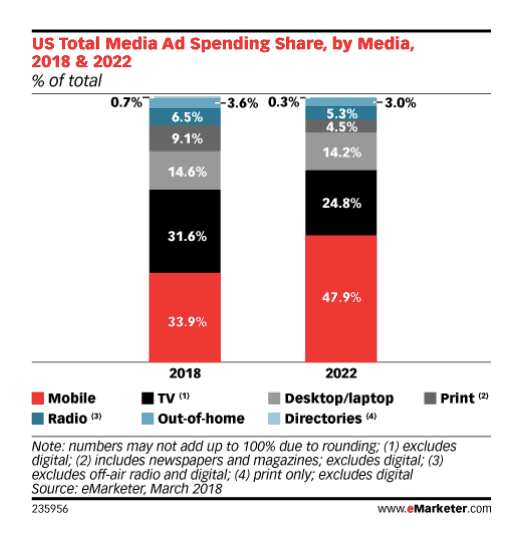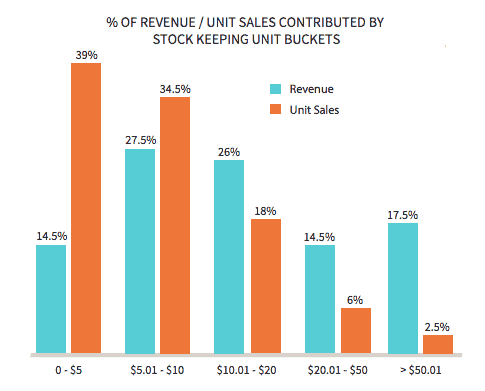The majority of the apps in the App Store and Google Play Store today are free.
Surprised?
Since most businesses can’t survive without making money, it can be hard to understand how giving away your product for free will result in financial gain.
The truth is, you can make money by offering your app for free. It’s been proven time and again. Consider Facebook and Snapchat—these are both publicly traded companies that offer free apps.
Offering an app for free is a great way to gain awareness for your business and attract users very quickly. If you do it right, you can see great returns in the long run. But choosing a free app pricing model can cause issues if you go about it the wrong way.
Today we’re going to explain how you can monetize your free app and what you need to do to make your mobile pricing strategy successful.
There are two primary ways to monetize a free app:
1) Sell Ad Space Within Your App
Many mobile app developers make money on their free apps by selling data-driven ad space within the platform. This is done independently or by pairing up with a mobile ad partner.
There are five business models that drive mobile ad revenue:
Cost per mille (CPM) – An advertiser pays for every 1,000 views of their ad.
Cost per click (CPC) – An advertiser pays for each click on their ad.
Cost per install (CPI) – An advertiser pays when their clicked ad results in an install of their advertised app.
Cost per action (CPA) – An advertiser pays when a click leads to a specific action such as installing an app, making a purchase, submitting a form or subscribing.
Cost per view (CPV) – An advertiser pays for each view of their video mobile ad.
According to eMarketer, mobile ad spending will account for a third of all ad spending in the U.S. this year alone, growing to nearly half of all ad spending by 2022. As you can see below, this will far surpass traditional media like television, print and radio.

If you add up all the minutes the average person spends on their phone, it comes to about 23 days a year, and people spend most of that time using apps—so some serious cash can be made with in-app advertisements … if you have the right approach.
Here’s How You Can Do It Effectively
1. Choose the right ad type
There are four primary in-app ad formats:
Interstitial ads cover the entire screen of the app. These are usually encountered when transitioning from screen to screen while using the app.
Banner ads appear either at the top or bottom of the screen. They can be static or animated.
Native ads are banners or videos that take on the formatting of the app and fit organically within the interface, such as in-feed ads.
Video ads come in two formats: instream ads, which play before, during or after video content; and outstream ads, which are standalone rather than attached to another video.
The right ad format is the one (or more than one) that won’t annoy users too much but will generate the revenue you’re looking for.
You don’t want to allow ads that will totally disrupt the user experience. Ask yourself, What kinds of ads would my users like to see? and How does this ad reflect on my brand? Your app’s purpose, functionality and interface will affect the answers to these questions—ads that feel organic in one app might be disruptive in another. But if you want to keep users engaged in your app, it’s generally wise to consider expandable banner ads instead of ads that drive users away from your app to a separate landing page, and CPM ads rather than CPC or CPA ads that won’t make you money unless they’re clicked.
2. Focus on delivering value
No matter what kind of ads you allow, they’re going to affect the user experience. You have to make sure that the experience is worth sticking around for despite the disruptions.
As mentioned, the free pricing model is a great way to gain users quickly because they don’t have to make any kind of commitment. But it also proves tricky to maintain loyalty and engagement because users don’t have any skin in the game.
If users don’t like your app, they can simply delete it, no questions asked.
As such, you need to be continually showing your users why they should stay with your app. Regularly update with new features, give users the option to invite their friends, offer targeted or personalized content—these are all effective ways to maintain interest in your free, ad-based app.
But ads are not the only way to monetize a free app…
2) Offer In-App Purchases
Developers who choose a freemium pricing model for their app can reap major long-term rewards. Here’s how it works: The app is free to download, but users are offered ongoing incentives in the form of paid upgrades or in-app purchases.
Generally speaking, there are three types of freemium apps:
Free with ads – The free app contains ads but users have the option to upgrade to an ad-free version. Example: Spotify.
Free for a limited time – Users can download and use the app for free for a period of time, after which they must pay to continue using the app. Example: Netflix.
Free with added features – The app is free to download and use, but users can pay for premium features. This is very common in gaming apps where users are offered incentives such as bonus lives, in-app currency and boosters. Example: Candy Crush.
According to an in-app spending report by AppsFlyer, only 5.2% of app users actually make in-app purchases. That being said, according to a mobile monetization report by Swrve, the amount users spend rather than the number of purchases they make has the biggest impact on revenue. In fact, as Swrve’s study points out, features and upgrades range from under $5 to $50+, and while purchases of over $50 accounted for just 2.5 percent of all purchases, they made up 17.5 percent of revenue.

Allowing people to “try before they buy,” so to speak, is a great way to stir interest in your app and begin building loyalty and engagement.
Here’s How You Can Do It Effectively
1. Be upfront about it
Don’t promote an app as free if it’s not really free. You must clearly spell out in the App Store description and preview what users can expect to get from your app. You can count on losing users for good if they settle into your app only to learn that they can’t access even its most basic features without forking over money. Which brings us to our next point…
2. Make the experience valuable for everyone
Make sure your freemium app has enough truly free features that users who choose not to pay for add-ons still see value in using your app. At the same time, you don’t want to offer so much for free that they see no value in paying for more. It’s a difficult balance to strike!
Freemium app users expect to get their money’s worth if they shell out for upgrades and add-ons. More likely than not, there’s a similar app in the App Store they could download instead, so you want to make sure they get what they want from the paid experience.
3. Offer a range of SKUs at different price points
As the Swrve report mentioned above points out, there is value to be gained from all price points. Some users may make a few purchases ranging from $0 to $5, but one or two may make a $50 purchase. Cover your bases and give your users options.
4. Don’t bombard users with upgrade notifications
Users of freemium apps definitely expect incentives and upgrade offers, but not so many that it disrupts the user experience. Be reasonable with your ask by offering upgrades quarterly or timing your notifications to come through on app startup rather than during use.
Conclusion
Either of these app pricing models—ad-based or freemium—can prove to be profitable for your business long term. Offering your app for free is one way to get a lot of downloads upfront and, therefore, rapid growth.
Both strategies can work well in almost any industry. The key is to make sure the strategy you choose fits the type of app you’re offering and the people you’re targeting.
Whether you go with ads or paid upgrades, remember: Your users always want to see the value they will gain from downloading your app vs. the hundreds of thousands of other apps available in the App Store. A free app may encourage an install, but a fantastic user experience inspires engagement and loyalty—and that is how you build lifetime value.
Choosing the right pricing strategy for your app is one of the most important things to do before launching your app. Want to know if you’re on track with your launch? Check out the other seven items on the pre-launch checklist here and then reach out if you’d like to chat further!



